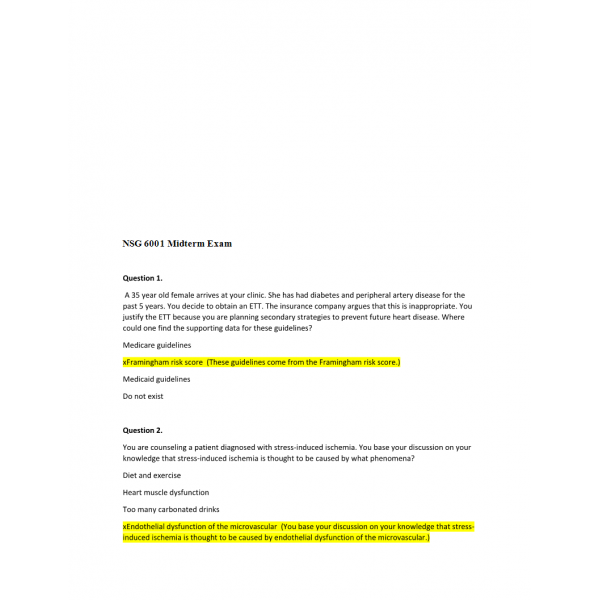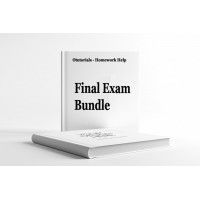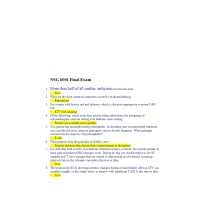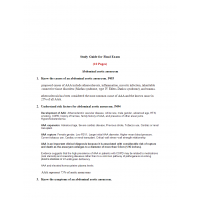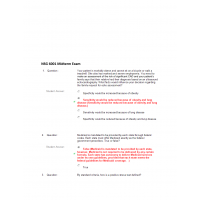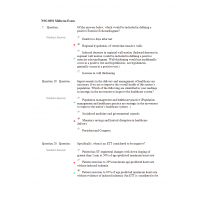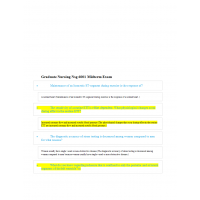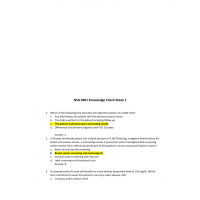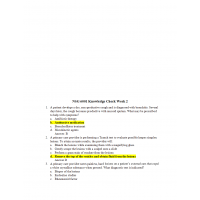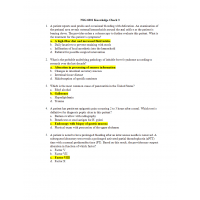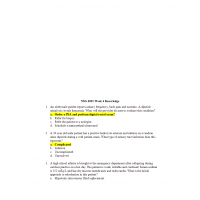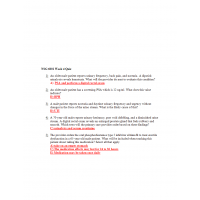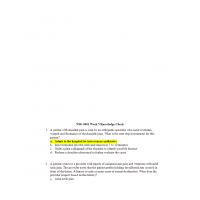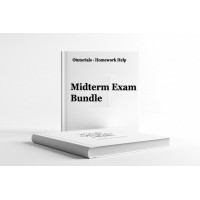NSG 6001 Midterm Exam
1. A 35 year old female arrives at your clinic. She has had diabetes and peripheral artery disease for the past 5 years. You decide to obtain an ETT. The insurance company argues that this is inappropriate. You justify the ETT because you are planning secondary strategies to prevent future heart disease. Where could one find the supporting data for these guidelines?
2. You are counseling a patient diagnosed with stress-induced ischemia. You base your discussion on your knowledge that stress-induced ischemia is thought to be caused by what phenomena?
3. What happens to coronary flow related to CAD?
4. A 47-year old female with general complaints of fatigue and shortness of breath shows up in your clinic as a referral from another nurse practitioner. Several blood tests and chest x-rays have been completed without any diagnosis or outstanding abnormalities. You decide to order an ETT despite the fact that the recent ECG does not show any abnormalities. From the answers below, which would be the best answer to support your decision?
5. You are in the clinic with your mentor observing the Echocardiogram exercise test of a 45-year old male that has been experiencing slight chest pressure almost daily during exercise. While observing your patient, your mentor points out that the left ventricle wall is thinning and there is some hyperkinesias of the ventricular wall. From your time in the clinic, you know that this test will be considered to be what type of result?
6. On the echocardiography during the ETT you notice the following change: abnormal left ventricular ejection fraction. What do these changes suggest related to this patient?
7. Population disease management is a term used to describe:
8. Why would inability to exercise reduce the specificity of the routine ETT?
9. All patients, even if asymptomatic, require risk stratification according to the Farmingham risk score. At present, ACC/AHA guidelines, however, do not normally support stress tests for asymptomatic patients without additional justification. From the list below, what could be used to justify an ETT in an asymptomatic patient?
10. What is the leading cause of death for women in the United States?
11. In women, you need to know the limitations of certain tests for CAD. For example, single-photon emissions CT imaging, while an acceptable test for most men and some women, is technically limited in women for two reasons. From the following, choose the best possible answer.
12. What are two of the most common forms of Exercise Stress Tests used today?
13. Improvements in the delivery and management of healthcare are necessary if we are to improve the overall health of this nation’s population. Which of the following are identified in your readings as strategic in the movement to improve the healthcare system?
14. For women with known CAD and diabetes, which is most appropriate to assess CAD risk?
15. What is considered the first-line initial approach to test for CAD?
16. Encouragement of patients to take effective actions in their own healthcare refers to the concept of:
17. Ischemic changes on ECG during ETT is highly predictive of CAD. What is another important strong predictor of CAD that you might see during an ETT?
18. Maintenance of an Isoelectric ST-segment during exercise is the response of?
19. What ECG changes can reduce the specificity of the ETT?
20. Your patient has a maximum age-predicted heart rate of 180. During the exercise, he reaches a heart rate of 140 and then states he can no longer exercise. You see no evidence of ischemia on the ECG. This would be diagnostic for what condition?
21. We all know that collaboration is integral to becoming a successful nurse practitioner. Among collaborations, however, only one can be considered as the most important. While each example below is important, which is the most important collaboration? The one that occurs:
22. As patients that entrust our care to another individual, we always expect honesty to avoid leading us down a deceptive pathway in our healthcare decisions. Adherence to which principle compels providers to be truthful?
23. What do you know regarding ischemia that is confined to only the posterior and or lateral segments of the left ventricle?
24. Your patient is morbidly obese and cannot sit on a bicycle or walk a treadmill. She also has marked and severe emphysema. You need to make an assessment of the risk of significant CAD and your patient’s family says that their relative had their diagnosis based on an ultrasound echocardiography. What facts would influence your decision regarding the family request for echo assessment?
25. Your mentor says that you should be prepared to know how to determine the maximum heart rate for your patient during the ETT. How is the age-predicted maximum heart rate during an ETT determined?
26. You are considering adding an adjunctive form of testing to detect wall motion abnormalities during the ETT. You select Echocardiography as the added testing. You choose this test because you know that echocardiography does what when added to a standard ETT?
27. Your patient underwent an exercise stress test for CAD. There is significant elevation of the ST-segment. What do you need to know about these changes to manage your patient’s care?
28. The sensitivity of a routine ETT is effort dependent. What physiological changes occur during effort in the routine ETT?
29. What purpose does the principle of fidelity serve in the provider/patient relationship?
30. A 55-year old man is referred to your clinic. He has been sedentary all of his life, is gaining weight and wishes to get into better physical shape. He has never had any chest pain or shortness of breath when walking or climbing a flight of stairs. Before recommending a vigorous exercise routine for this patient, you order what test?
| Institution & Term/Date | |
| Term/Date | South University |
NSG 6001 Midterm Exam 2
- Product Code: 2019
- Availability: In Stock
-
$25.00
Related Products
NSG 6001 Final Exam 1
$45.00
NSG 6001 Midterm Exam 1
$25.00
NSG 6001 Midterm Exam 3
$15.00
NSG 6001 Midterm Exam Review
$25.00

